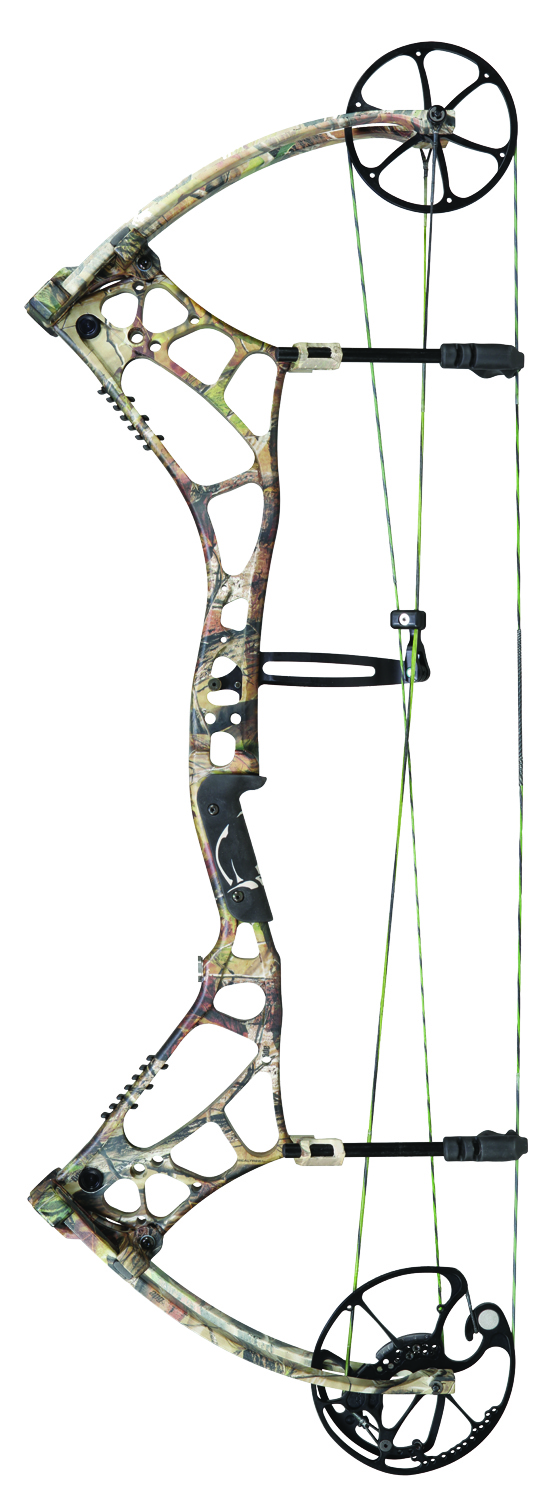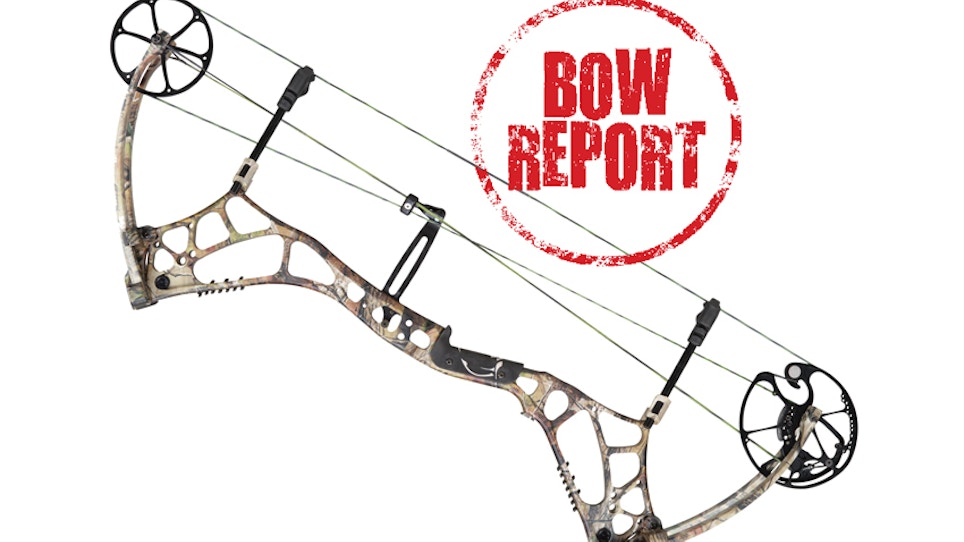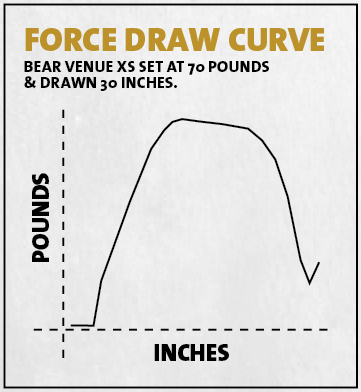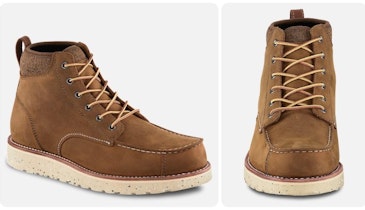Bear Archery introduced no fewer than 10 new bows for 2014; the Venue takes over the role of flagship single-cam from last year’s Empire, which is still available. Built around the same S13 Cam with 80 percent letoff and a modular draw range adjustment of 24 to 31 inches, the two bows are remarkably similar in performance and specifications. The Venue’s riser is very different, being more widely flared with more cutouts, and it appears to be the same riser found on Bear’s two new Agenda bows.
 The Venue does boast some newer technology in the form of the rubber riser inserts to absorb vibration and noise, an updated version of Bear’s Zero Tolerance Limb Pockets, and the new Bear Hinge Guard. The Hinge Guard functions differently from other torque-reducing cable guard systems that tend to flex or allow the cable guard to slide inward on a curved rod. The Hinge Guard, as the moniker suggests, is hinged. The cable guard swings back and in as the bow is drawn, returning to its original position as the arrow is released. A more centralized mount for this system allows for a lighter riser.
The Venue does boast some newer technology in the form of the rubber riser inserts to absorb vibration and noise, an updated version of Bear’s Zero Tolerance Limb Pockets, and the new Bear Hinge Guard. The Hinge Guard functions differently from other torque-reducing cable guard systems that tend to flex or allow the cable guard to slide inward on a curved rod. The Hinge Guard, as the moniker suggests, is hinged. The cable guard swings back and in as the bow is drawn, returning to its original position as the arrow is released. A more centralized mount for this system allows for a lighter riser.
The Venue also employs the same aggressive, parallel, Max Pre-load Quad limbs that are found on all Bear’s premium bows, along with Bear’s removable overmold grip sporting the Bear logo, which can be removed to reveal sideplates for shooters who prefer a very narrow grip.
A hallmark of Bear bows is the modular cam system that allows for a relatively wide range of adjustment, often without the need to press the bow. There are advantages and disadvantages to adjustable modular as opposed to non-modular systems. I’ll make the case here for the modular adjustable system. First, ideal draw lengths can change over time. New or less experienced bowhunters often find themselves experimenting with draw length over time until they settle on the ideal precise draw lengths. (And if they don’t, they should.) Second, I believe that, depending on the angle of the string at full draw (which depends on axle-to-axle length and brace height), the ideal draw length for an individual shooting one bow might be different for a different bow. Being able to tweak draw lengths offers real advantages in both cases. Shooters used to twist strings or cables to tweak draw lengths, but often makers of today’s premium strings, designed to greatly reduce or eliminate creep, recommend twisting be kept to a minimum or not be done at all.
Fit and finish on the bow tested was excellent, as you’d expect with a flagship bow from an established manufacturer. The model I tested had a Realtree Snow riser with black limbs and components, and on an subjective note, was among the cooler-looking bows I’ve seen this year.
Shooting The Bow
I’ve found Bear bows in recent years to be on the easy side of set up and tune, and the Venue was no exception. Vertically, the center of the arrow should align with the center of the Berger or sight mount holes. Horizontally, Bear recommends placing an arrow flush against the inside of the riser. When the arrow in the rest is parallel to it, the rest is at center shot. Manufacturers usually caution that their recommended center shot is only a starting point. I’d suggest that if your shooting form is good and your arrows are properly spined, it can often be an ending point as well. In any case, this method works very well for me with Bear bows. Arrow flight with field points was excellent immediately, and with sight pins aligned with the string and arrow, sighting-in required only a few quick adjustments.
The Venue is touted for its smooth-drawing properties. My own impression and, perhaps what’s more important, the draw force curve confirm that. No humps or bumps or sudden drop-offs—just a very smooth pull that builds steadily to a peak before transition to its 80 percent letoff. The back wall is very solid without the need for limb or cable stops. At the shot the bow pops pleasantly forward in the hand, but without any noticeable shock or vibration. It’s very quiet, as well. At 330 fps the Venue is very quick as single-cam bows go.
Bear promotes the Venue as “possibly the best all-around hunting bow you can put your hands on. Especially if those hands are bone-tired after six hours in 30-degree weather.” Hunters who place a premium on pleasant shooting properties and low noise, with more than enough speed to hunt effectively for any species at any range, will find that the Bear Venue fills the bill nicely.
Bear Venue Specs
Letoff: 80%
Brace Height: 7 inches
Weight: 4 pounds
Axle-To-Axle Length: 32.25 inches
Speed: 330 fps
Draw Lengths: Modular-adjustable from 24 to 31 inches, no press required
Draw Weights: 50, 60 and 70 pound peak, adjustable down 10 pounds from peak
Options: Realtree APG, Shadow Series, Red/Black Series, Green/Black Series, APS (Snow)
Suggested Retail: $849.99
Objective Tests (30 Inches Draw)
Peak Hold*: 70 pounds
Weight, Full Draw*: 15.0 pounds
*Rounded to nearest half-pound
At 70-Pound Draw Weight
| Arrow Weight | Speed @ Launch | Speed @ 20 Yards | K.E. @ Launch | K.E. @ 20 Yards |
| 385 grains | 299 fps | 289 fps | 76.45 ft. lbs. |
71.42 ft. lbs. |
| 500 grains | 267 fps | 260 fps | 79.17 ft. lbs. | 75.07 ft. lbs. |
At 60-Pound Draw Weight
| Arrow Weight | Speed @ Launch | Speed @ 20 Yards | K.E. @ Launch | K.E. @ 20 Yards | Sound Level |
| 385 grains | 277 fps | 267 fps | 65.61 ft. lbs. | 60.96 ft. lbs. |
59.1 dBA |
| 500 grains | 247 fps | 239 fps | 67.75 ft. lbs. | 63.43 ft. lbs. | 47.2 dBA |







